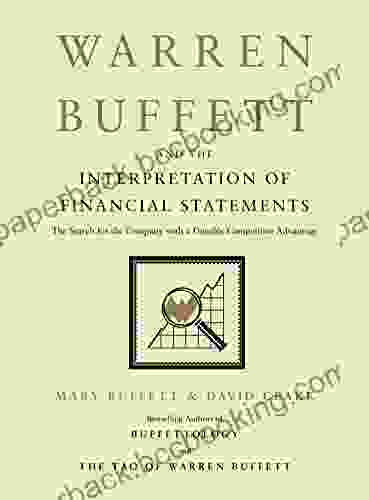Warren Buffett and the Interpretation of Financial Statements: Unlocking the Secrets of Value Investing

Warren Buffett is widely regarded as one of the greatest investors of all time. His investment philosophy, known as value investing, has helped him achieve incredible wealth and consistently outperform the market. At the core of Buffett's investment approach is a deep understanding of financial statements.
4.6 out of 5
| Language | : | English |
| File size | : | 1512 KB |
| Text-to-Speech | : | Enabled |
| Screen Reader | : | Supported |
| Enhanced typesetting | : | Enabled |
| X-Ray | : | Enabled |
| Word Wise | : | Enabled |
| Print length | : | 206 pages |
Financial statements provide a wealth of information about a company's financial health, performance, and prospects. By carefully interpreting these statements, investors can gain valuable insights into a company's strengths, weaknesses, and true value.
In this comprehensive guide, we will explore the key financial statements and ratios used by Warren Buffett and other value investors. We will learn how to analyze these statements to assess a company's profitability, financial strength, and future growth potential.
The Income Statement
The income statement provides a snapshot of a company's financial performance over a specific period of time, typically a quarter or a year. It shows the company's revenues, expenses, and net income.
One of the most important financial ratios derived from the income statement is the gross profit margin. The gross profit margin measures the percentage of revenue that a company keeps after paying for the cost of goods sold. A higher gross profit margin indicates that a company is able to generate more profit from its sales.
Another key ratio is the operating profit margin. The operating profit margin measures the percentage of revenue that a company keeps after paying for the cost of goods sold and operating expenses. A higher operating profit margin indicates that a company is able to control its costs and generate more profit from its operations.
The Balance Sheet
The balance sheet provides a snapshot of a company's financial health at a specific point in time. It shows the company's assets, liabilities, and equity.
One of the most important financial ratios derived from the balance sheet is the current ratio. The current ratio measures a company's ability to meet its short-term obligations. A higher current ratio indicates that a company has more assets available to cover its short-term liabilities.
Another key ratio is the debt-to-equity ratio. The debt-to-equity ratio measures the amount of debt that a company has relative to its equity. A higher debt-to-equity ratio indicates that a company is more leveraged and may be at greater risk of financial distress.
The Cash Flow Statement
The cash flow statement provides a summary of a company's cash inflows and outflows over a specific period of time. It shows how a company generates and uses cash.
One of the most important financial ratios derived from the cash flow statement is the free cash flow. Free cash flow measures the amount of cash that a company generates from its operations after paying for capital expenditures. A higher free cash flow indicates that a company has more cash available to distribute to shareholders or invest in new growth opportunities.
Putting It All Together
By carefully interpreting the income statement, balance sheet, and cash flow statement, investors can gain a comprehensive understanding of a company's financial health, performance, and prospects. This information can be used to make informed investment decisions and identify companies that are undervalued by the market.
Warren Buffett has used this approach to investing for decades, and it has helped him achieve incredible wealth. By following in his footsteps, you can learn how to interpret financial statements and become a more successful investor.
Free Download your copy of Warren Buffett and the Interpretation of Financial Statements today and start unlocking the secrets of value investing!
Buy Now on Our Book Library
4.6 out of 5
| Language | : | English |
| File size | : | 1512 KB |
| Text-to-Speech | : | Enabled |
| Screen Reader | : | Supported |
| Enhanced typesetting | : | Enabled |
| X-Ray | : | Enabled |
| Word Wise | : | Enabled |
| Print length | : | 206 pages |
Do you want to contribute by writing guest posts on this blog?
Please contact us and send us a resume of previous articles that you have written.
 Book
Book Novel
Novel Page
Page Chapter
Chapter Text
Text Story
Story Genre
Genre Reader
Reader Library
Library Paperback
Paperback E-book
E-book Magazine
Magazine Newspaper
Newspaper Paragraph
Paragraph Sentence
Sentence Bookmark
Bookmark Shelf
Shelf Glossary
Glossary Bibliography
Bibliography Foreword
Foreword Preface
Preface Synopsis
Synopsis Annotation
Annotation Footnote
Footnote Manuscript
Manuscript Scroll
Scroll Codex
Codex Tome
Tome Bestseller
Bestseller Classics
Classics Library card
Library card Narrative
Narrative Biography
Biography Autobiography
Autobiography Memoir
Memoir Reference
Reference Encyclopedia
Encyclopedia Sophie L Morgan
Sophie L Morgan Tarani Chandola
Tarani Chandola Peter Buse
Peter Buse Michael Mcteigue
Michael Mcteigue Tom Dodd
Tom Dodd Tim Jeal
Tim Jeal Martha R Severens
Martha R Severens Todd Havens
Todd Havens Michael Makovsky
Michael Makovsky Steve Biko
Steve Biko Lori Anna Harrison
Lori Anna Harrison Lara Mercado
Lara Mercado L Elizabeth Forry
L Elizabeth Forry Peggy Mastel
Peggy Mastel Maggie Ryan
Maggie Ryan Melinda Woodhall
Melinda Woodhall Tamonya Sands
Tamonya Sands Michael Pronko
Michael Pronko Stephen Earle
Stephen Earle Sasha Su Ling Welland
Sasha Su Ling Welland
Light bulbAdvertise smarter! Our strategic ad space ensures maximum exposure. Reserve your spot today!

 Chadwick PowellUnleash the Inner Party Planner: Celebrate Kids' Birthdays on a Shoestring...
Chadwick PowellUnleash the Inner Party Planner: Celebrate Kids' Birthdays on a Shoestring... Evan HayesFollow ·16.3k
Evan HayesFollow ·16.3k Eddie PowellFollow ·9.2k
Eddie PowellFollow ·9.2k Clarence BrooksFollow ·4.2k
Clarence BrooksFollow ·4.2k Peter CarterFollow ·5.4k
Peter CarterFollow ·5.4k F. Scott FitzgeraldFollow ·13k
F. Scott FitzgeraldFollow ·13k Neil GaimanFollow ·19.9k
Neil GaimanFollow ·19.9k Amir SimmonsFollow ·10k
Amir SimmonsFollow ·10k Everett BellFollow ·10.1k
Everett BellFollow ·10.1k

 E.M. Forster
E.M. ForsterBluewater Walkabout: Into the Pacific
An Unforgettable...

 Joseph Foster
Joseph FosterUnlock the Secrets of Standardized Test Success with Test...
Are you tired of struggling with standardized...

 Joe Simmons
Joe SimmonsUnlock Learning with Flash Cards for Kindergarten:...
Ignite a Passion for...

 Raymond Parker
Raymond ParkerJourney into the Enchanting World of "The Heart Kingdom"...
A Timeless Tale of Love,...
4.6 out of 5
| Language | : | English |
| File size | : | 1512 KB |
| Text-to-Speech | : | Enabled |
| Screen Reader | : | Supported |
| Enhanced typesetting | : | Enabled |
| X-Ray | : | Enabled |
| Word Wise | : | Enabled |
| Print length | : | 206 pages |














